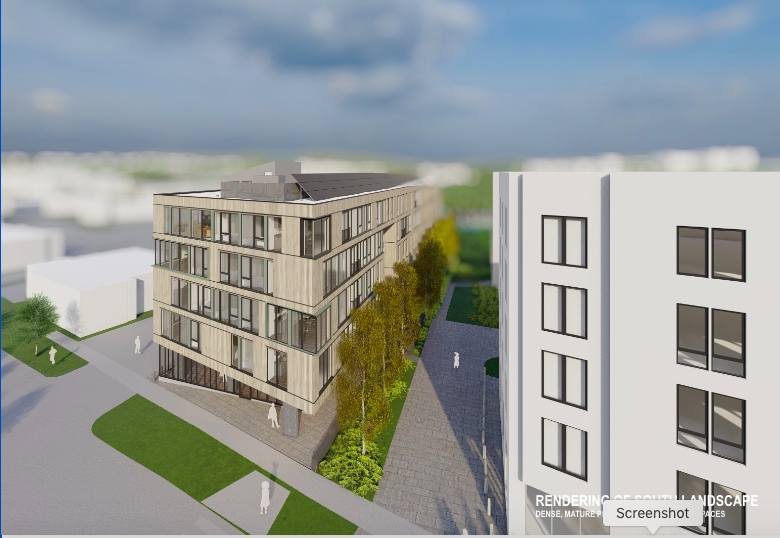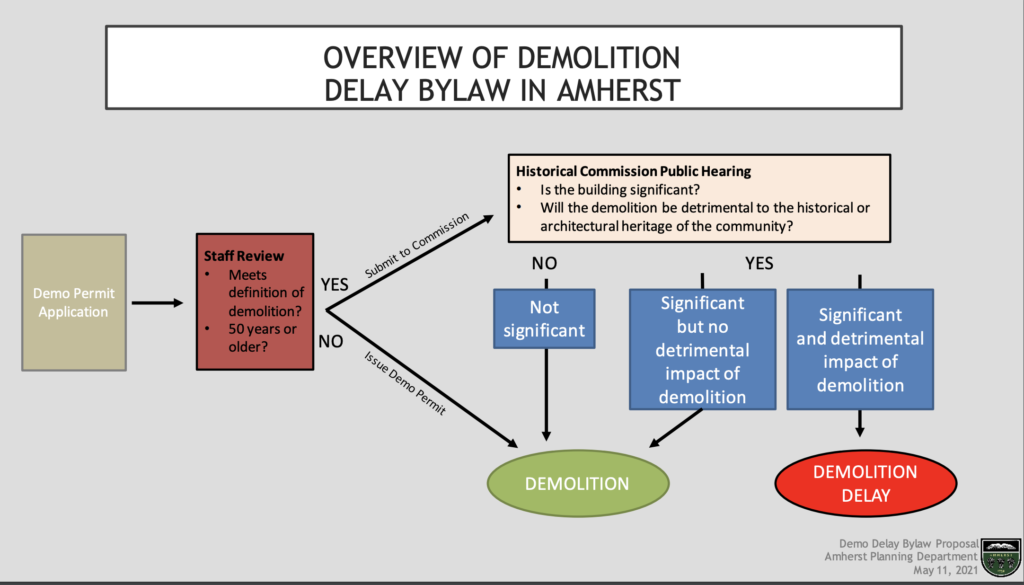CRC Rejects Temporary Downtown Building Moratorium

Architect's rendering of apartment building at 11-13 East Pleasant Street viewed from west. 1 East Pleasant Street is pictured to the south (right). Photo: Amherst Planning Department
Report On The Meeting Of The Community Resources Committee (May 25, 2021)
The meeting was conducted via Zoom and was recorded. The recording may eventually be posted on the Town’s ZBA YouTube channel.
Present
Community Resource Committee (CRC)members: Councilors Mandi Jo Hanneke (At large, Chair), Dorothy Pam (District 3), Stephen Schreiber (District 4), Evan Ross (District 4), Shalini Bahl-Milne (District 5)
Staff: Nate Malloy and Ben Breger, Planning Department.
Highlights:
- By a vote of 4-1, CRC recommended that Town Council reject the proposed temporary downtown building moratorium
- CRC raised concerns about the proposed Inclusionary Zoning bylaw amendment; discussion will continue.
- Planning Department presented proposed demolition delay bylaw.
- CRC noted that a discussion of footnote m (with possible consideration for removal from the Town Zoning Bylaws) will be brought back before the CRC some time in the future
- Interviews for ZBA candidates will be delayed until June 23 as there are four openings and only one person has applied.
The Community Resources Committee of the Town Council (CRC) voted 4-1 to recommend that the Town Council reject the proposed amendment to the Town Zoning Bylaw – Article 16, that would enact a 180-day moratorium on the issuing of building permits downtown, specifically in the BL, BG, and RG zones, for residential projects of three or more units.
The Planning Board voted unanimously last week to recommend that the Council reject the same Article.
The Council will vote on the proposed moratorium after it receives a recommendation from the Government, Organization and Legislation Committee (GOL), which has yet to take up the matter.
Discussion
Dorothy Pam spoke in favor of the moratorium, noting that there is much concern among residents about what is happening downtown and that the moratorium would give the Town a chance to complete its ongoing work on revising the Zoning Bylaw with new zoning that would address many of those concerns. Especially important among the proposed changes would be the introduction of design guidelines that would ensure that developers conform to standards for things like setbacks and open space.
The other members of the committee disagreed with her, arguing that a six- to nine-month moratorium was not sufficient time to resolve anything, and that in the end, a moratorium, no matter how well intentioned, would do more harm than good. They were also very concerned that a moratorium might discourage developers from undertaking new projects in Amherst even after the moratorium had expired.
Councilor Steve Schreiber pointed out that the most recent projects that have been approved are in fact replacing “open” or “degraded” space and, hence, are “an improvement to downtown aesthetics” and would do “no harm” to the cultural character of the area. 11 E Pleasant is replacing a parking lot, he said, “so it really isn’t imposing on any cultural properties.” He added that there are “no projects right now that would impact the historical /cultural character of the area that the moratorium proposes to protect.”
Councilor Evan Ross complained that “our town has a reputation for being anti-business. Our staff has worked really hard to dispel that reputation and to become more responsive to developers, for example by making permitting more efficient. The moratorium hurts our efforts to send the message that Amherst is open for business and it is an attractive place to invest and develop. We don’t want to scare investors off. This would make us seem like a riskier place to invest and sends the message that we are not interested in participating in economic recovery.”
Pam responded noting that there is very little flexibility offered in recent designs. “The mixed-use buildings on East Pleasant are not able to have offices on the second floor because of frame construction. And Spring Street is a design disaster and the Planning Board ignored all of the recommendations against the design.”
She further stated that she wants to preserve the old buildings on the west side of Kendrick Park. She suggested that the Town should talk with and work with Amherst developer Barry Roberts. ” We don’t want both sides of the street to become like the east side. Right now we don’t have the rules to regulate that. The moratorium will give the Planning Department time to complete their work and come up with design guidelines that we need [to]protect the things we want to protect. It’s only a short amount of time,” she said.
Ross countered that since nothing has been explicitly proposed for the west side of Kendrick Park, the moratorium would have no impact on that side of the street but it would have an impact on the Town’s reputation.
Hanneke stated that there is not enough time to get “all of the desired zoning changes” during the brief moratorium and that “the potential for renewing it could turn a six-month moratorium into a two-year moratorium.” She felt that very little potential benefit would be derived from the moratorium, but there is considerable potential harm to the Town.
Pam asked, “What do you say to the many people who are concerned that Amherst has taken a wrong turn and are very upset with the direction that downtown seems to be taking? The desire to protect certain aspects of the downtown is not coming from a small group of people. It is a considerable group of people. So, what would you do?”
Haneke responded, “Let’s get to work to modify the B-L zoning, and on our work on apartments, and mixed-use buildings” and “— “let’s just do the work that needs to be done.” She concluded that the moratorium, as it is written, would not accomplish its goals and that the CRC’s time would be better spent working on “the actual zoning we want to change” instead of improving the moratorium bylaw.
Ross noted that he was very disappointed in the way 40R Overlay zoning has been rejected for the downtown area. He believes that it would have provided 20 percent affordable units there and that there would have been some design “guidelines” and “many things that we want… and we devoted two years to it and then rejected it.”
Bahl-Milne reported that she spoke with some builders in Northampton who said that a moratorium increases the risk factor for builders but did not say how. She said that escalates the costs for developers and that is likely to make Amherst less attractive to them in the future.
Ross acknowledged that the new buildings in downtown Amherst have “very high rents,” but also asserted that a moratorium would impact multi-unit housing developments (and not single-family homes) and that this “will just exacerbate the housing crisis in Amherst and will disproportionately impact those who are most needy.” The Moratorium doesn’t pause the construction of single-family homes that are pretty much directed at the wealthiest. He said that “if we deter developers, that hurts our tax revenues.” He also said that a moratorium would “make Amherst less competitive for housing choice grants” going forward and that Framingham’s moratorium in the 1970s, during an economic downturn and it slowed their recovery. He did not mention the length of Framingham’s moratorium.
The motion recommending that the Town Council reject Article 16 passed 4-1 with Pam dissenting.
Inclusionary Zoning
The Committee continued its discussion of the proposed revision of the Zoning Bylaw to increase Inclusionary Zoning (IZ) in Amherst.
The Councilors expressed general discomfort with the proposed IZ bylaw, feeling that it would impose an “unfair burden on developers,” although they acknowledged that the Town needs more affordable housing and that IZ is a proven way to create it.
Schreiber said he is concerned that the proposed inclusionary zoning “amounts to a [property] taking — appropriating the property of developers without proper compensation.” According to Schreiber, “We do need more affordable housing, but we are putting that on the backs of developers. If we’re going to do this, we need to give something back…. Typically, the exchange with IZ is that you give back more market rate units to compensate for their building of affordable units…. But it’s not clear that the scale of development in Amherst is conducive to that.”
He noted that the current IZ provisions in Amherst have not created many affordable units, and concluded that the Town should phase-in better regulations.
Bahl-Milne expressed concern that IZ would “deter smaller builders, the very ones we want to encourage—and in the end we’ll end up with fewer affordable units.” She suggested excluding the BL transitional area downtown from requiring any affordable units “because that’s where we see the smaller builders.”
Pam reminded the Committee of the purpose of the proposed zoning revisions. “This is social justice in a small way, supporting a town of many different incomes and backgrounds. But our town is simply not open to [affordable for] new people. Everything we have read says that when it’s required, it works —and when it’s optional, it doesn’t,” she said.
The discussion will be continued at a future meeting.
Demolition Delay Bylaw
The Committee saw a PowerPoint presentation by planner Ben Breger about the proposed demolition delay bylaw. The full presentation can be viewed here. The draft of the proposed bylaw can be read here.
Some Key Points:
- A demolition delay bylaw offers an opportunity to save an imminently threatened building from loss.
- During the delay period, the building owner, community, and historical commission explore opportunities to preserve or move the threatened building.
- 160 municipalities in Massachusetts have a demo delay bylaw.
- Local Historical Commissions are the official agents of municipal government that areresponsible for historical planning. Their role is generally advisory unless a local bylaw, such as demolition delay, grants them regulatory jurisdiction.

Discussion
Bahl-Milnei asked how the significance of a structure is determined.
Breger responded that in Section 13.4. of the Zoning Bylaw there are 11 specific criteria for designating a building as significant, and the Historical Commission evaluates each one. If any one of the 11 are met, the structure is determined to be significant.
Hanneke asked how a building gets listed on the National Register of Historic Places and whether that requires the knowledge and permission of the owner. Malloy thought it would be unlikely that you could get something on the Register without the knowledge and support of the owner.
The rescission of the current demolition bylaw will require a public hearing but the adoption of the new bylaw will not. CRC will not see the bylaw again until the Historic Commission sends it to the Town Council for final approval.
Footnote m
Haneke reminded the Committee that Footnote m of the Zoning Bylaw (affecting housing density) will come back to CRC for discussion at some point after the revisions under consideration are approved.
Appointments
Hanneke reported that she had received only one application for four openings (two regular Members and two Associates) on the Zoning Board of Appeals (ZBA). The Committee agreed to solicit more applications and to postpone the interview date for candidates to June 23.
